When you are conducting a competitor analysis you will often ask yourself, “for which keywords of a domain does the competition also have rankings and how well are they doing?”. In order to make this evaluation as easy as possible, the SISTRIX Toolbox has the “Compare Keywords” feature. This tutorial will show you where to find this feature and how its use can pay off in your daily work.
An in-depth tutorial about keyword research and its prospects is also available for you to dive into the topic and learn more.
“Compare Keywords” in the SISTRIX Toolbox
This feature is a comparison for which we take all keyword-rankings from our expanded keyword data base for the chosen domain and compare them to the rankings of up to three additional domains. The result will be a long list with all the keywords for the initial domain and a colour coded matrix for the competitors’ rankings or other interesting sites you want to compare.
How is the men’s shoes directory on Debenhams doing compared to their competitors?
For this tutorial we deliberately decided not to evaluate the entire domain debenhams.com, but only one specific section. We do this foremost because we will get a more detailed picture of the keywords which match our question and additionally, our result lists will be much more tidy.
We start by typing-in our desired directory into the search bar of the SISTRIX Toolbox. If we want to evaluate a directory, it is important to enter the entire path, including the protocol. Therefore, we type http://www.debenhams.com/men/shoes-boots/ into the search bar and click on the magnifying glass.

This will yield us the overview page for the directory /men/shoes-boots/ on debenhams.com. Now we can click on “Competitors” in the left hand navigation and there we will find the feature “Compare Keywords”.
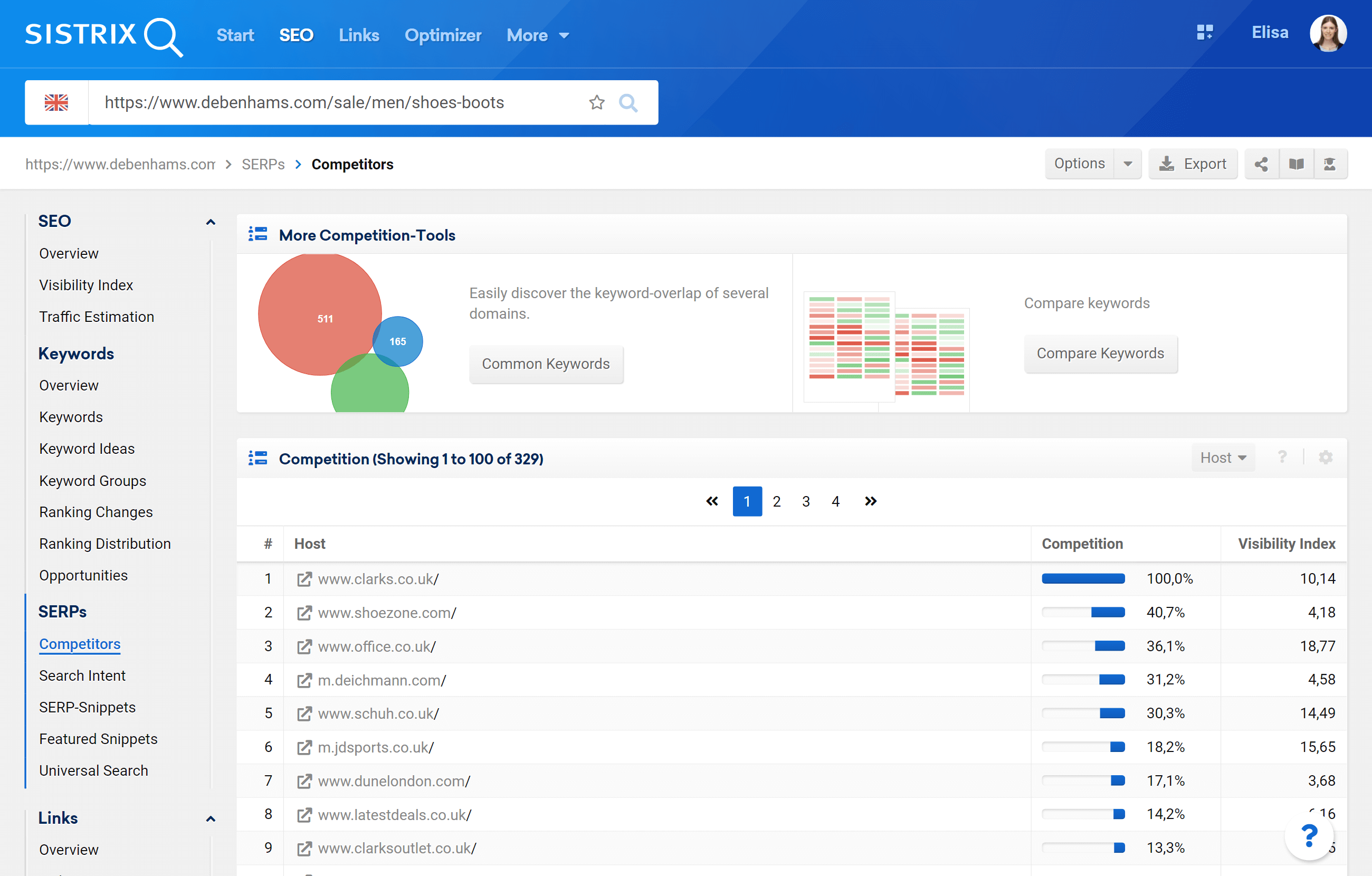
By clicking the button, a selection screen pops up in which you can specify up to three domains.
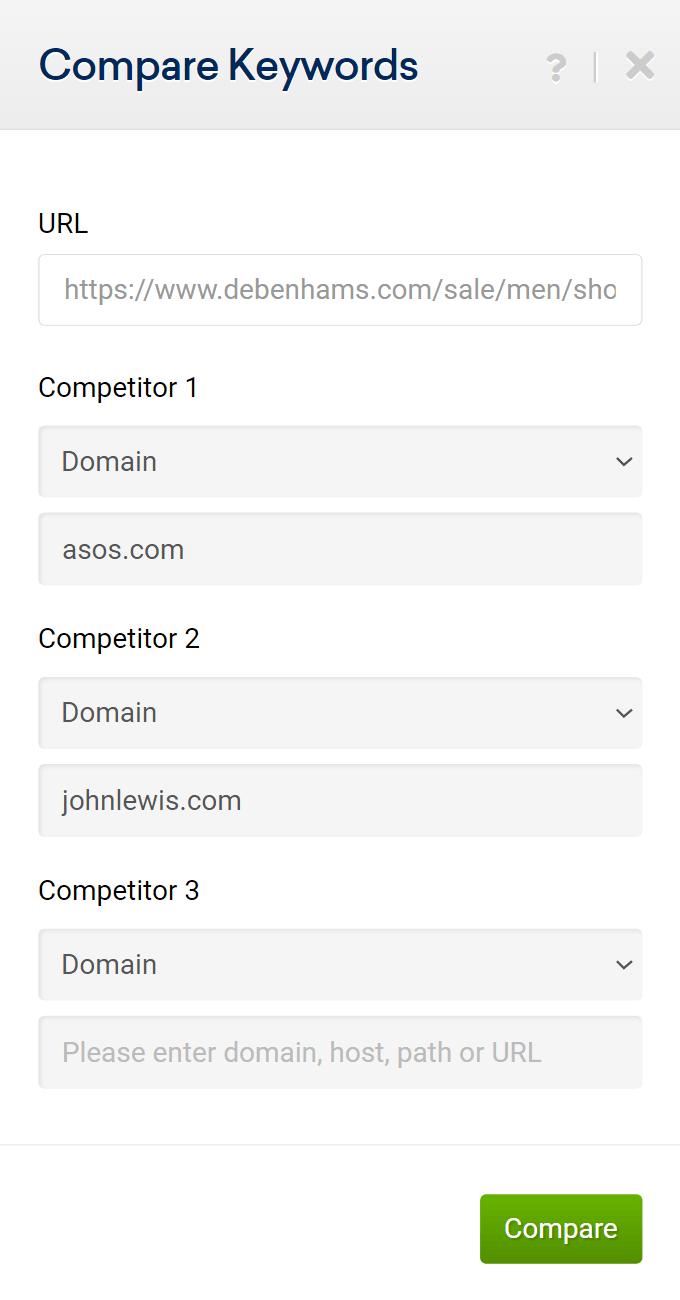
We could have also taken the time to figure out where the men’s shoes directories were on these two domains. But this may not always work, as not all domains use an internal structure with specific directories for their categories. Thanks to the way the “Compare Keywords” feature works, we do not have to, as we will only use the keywords where our initial directory on Debenhams has any rankings. That way we can simply use the entire competitor domain and still get useful results.
The result of our comparison is a large table which shows all the keywords for which http://www.debenhams.com/men/shoes-boots/ has a ranking within the Top 100 search results on Google.uo.uk:
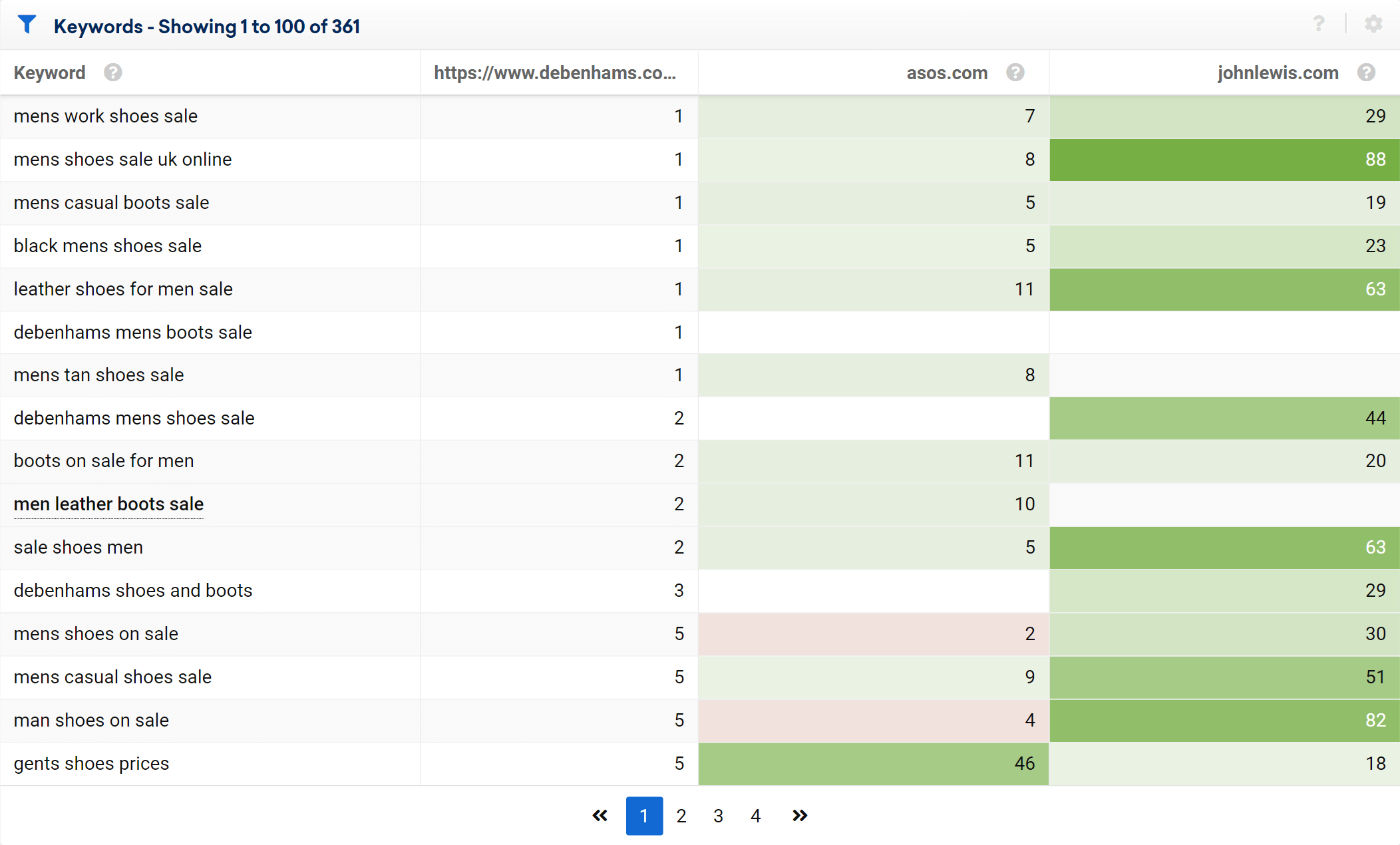
Here you can also see why it can be useful to compare specific sections or directories and refrain from comparing entire domains with each other. http://www.debenhams.com/men/shoes-boots/ already has rankings for about 360 keywords. This provides us with 4 pages of keywords to work through. If we had used the entire debenhams.com domain, we would have to work our way through more than 360.000 keywords, for example.
The list always shows the keywords of the first domain (or the host, directory or URL) sorted by position, from 1 – 100. In our example, we will first see the keywords with the best ranking for http://www.debenhams.com/men/shoes-boots/. Next, we can see the ranking positions for the other domains we entered. The fields are coloured according to how far away the rankings are from the first domain. The darker green the field, the further the two domains are away from each other, with the first domain having the better ranking. If the field is in a shade of red, then the second (or third) domain has a better ranking for the corresponding keyword.
If the other domain has no Top 100 ranking for that keyword, the field will stay empty. You can therefore easily tell, how much of an advantage certain keywords have, or how much catching up there needs to be done, thanks to this list.
For our example, we would now check for which keywords the /men/shoes-boots/ directory on Debenhams already has decent rankings and for which keywords there might already be a ranking outside of the top 20, which could use some work. In which case it may be worth it to check if the page that is ranking can be restructured to be more useful for the specific keyword, or if it may be necessary to create a new page for the keyword altogether.
Alternative consideration
We could also take a look at the keywords from a different angle, by evaluating the competitor’s men’s shoes directory. We would thereby see how our evaluation looks for our competitors point of view. After taking a look at the website structure for asos.com, we decided to use the http://www.asos.com/men/shoes-boots-trainers/ directory, as all of their shoes seem to be on pages within this specific directory.
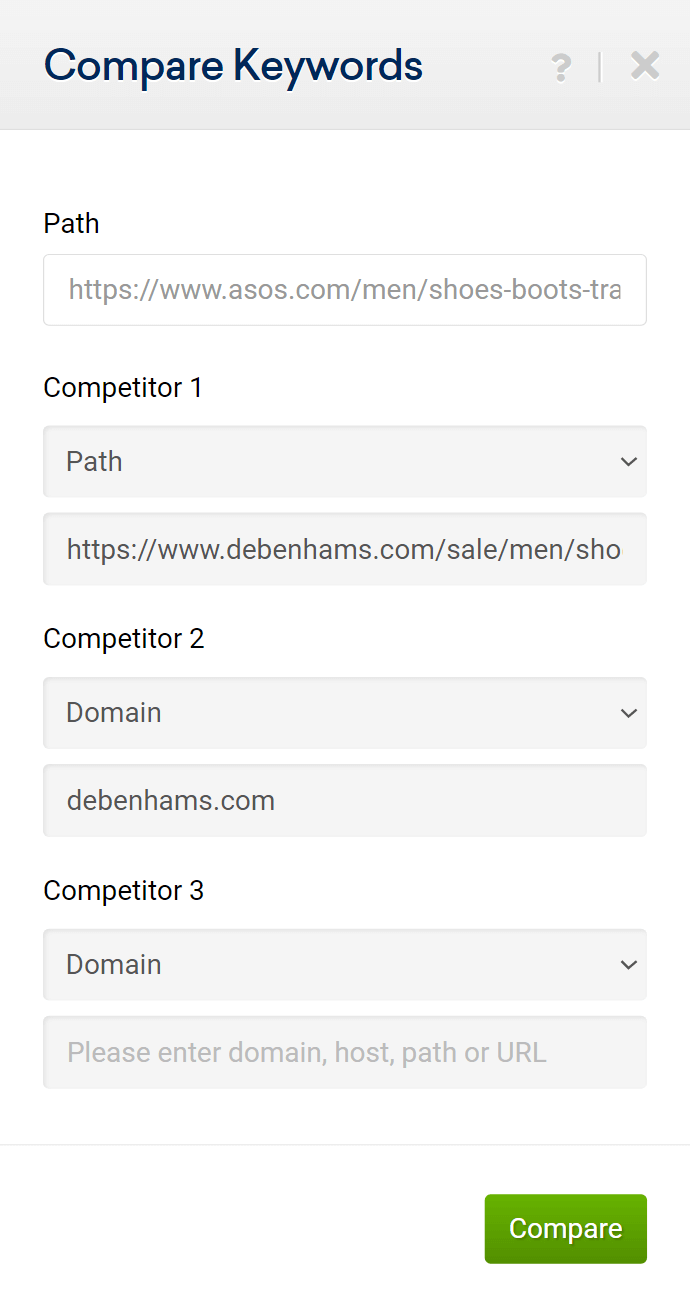
We will not use johnlewis.com this time, as we just want to focus on one competitor’s view. The reason we also added the entire debenhams.com domain besides the directory, is so we can check if there may be rankings somewhere else within debenhams.com for shoe related keywords, which are not within the /men/shoes-boots/ directory.
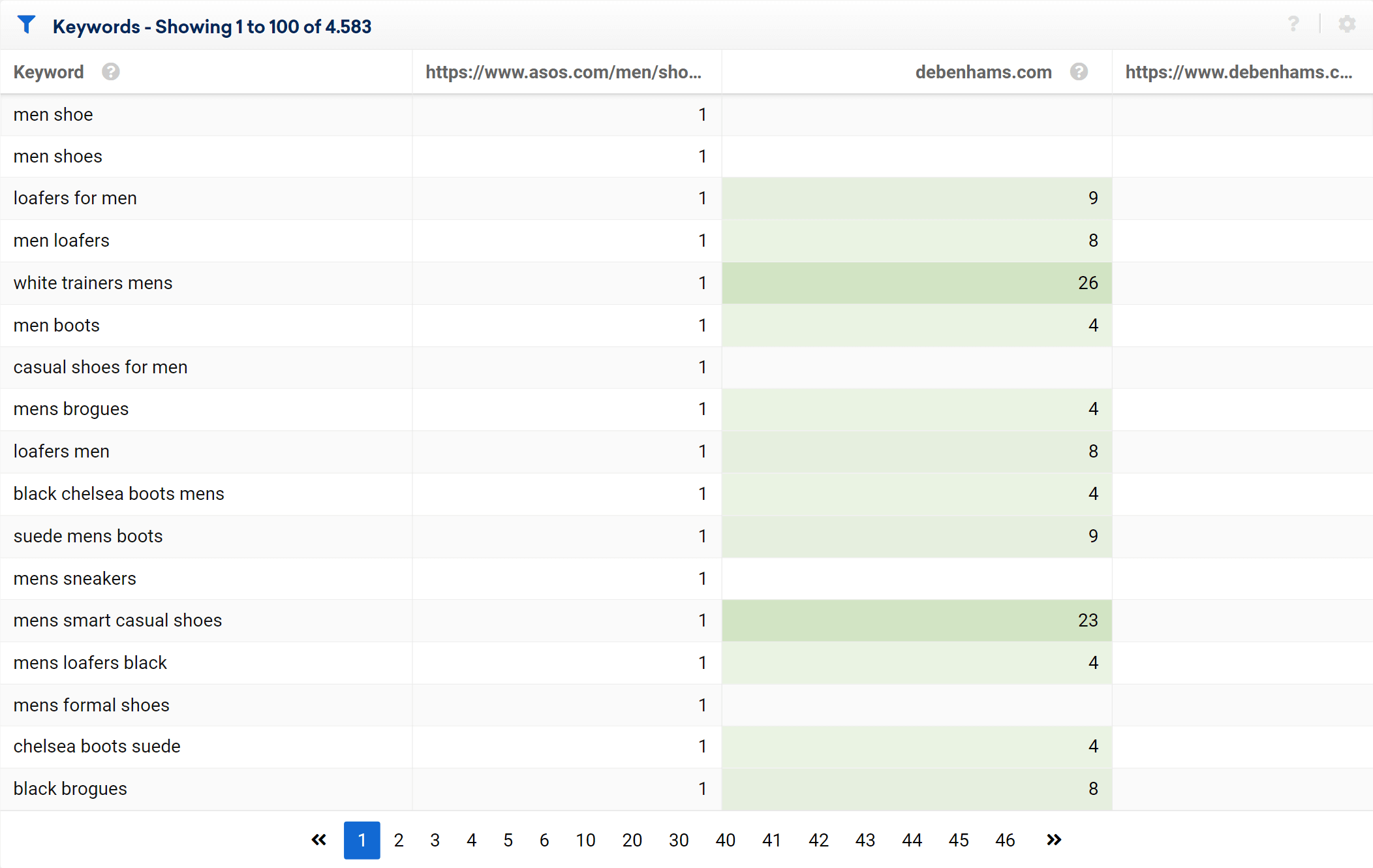
Having this list at hand, we can quickly gather the following information:
- For which keywords does http://www.asos.com/men/shoes-boots-trainers/ already have a ranking?
- How far apart are the corresponding rankings?
- For which keywords does debenhams.com not rank with any URL?
- Which keywords do not have a ranking for the /men/shoes-boots/ directory on debenhams.com?
- which leads to the question “For which URLs do these Keywords rank?”, which has to be examined.
In our example we can see that there are many keywords which do not appear in the /mens/shoes-boots/ directory but on another URL on debenhams.com. If we take a closer look at the keyword “men boots”, it becomes clear that Debenhams does have a ranking, although it is with their /women/shoes-boots/ directory.
This is the reason why it is so important to also include the entire domain in the evaluation. Only then can we recognize if a keyword is really missing or if, as in this case, a different directory is ranking for the keyword.
Conclusion
The “Compare Keywords” feature lets you create an overview of the ranking keywords for a specific domain and up to three competitors. Using the colour coded results matrix you can quickly recognize potential keywords for which you would like to work on better rankings.
If you use this feature with a competitor domain as the initial domain, you can easily recognize the keywords where you have worse rankings, or none at all. If you would only like to filter out the keywords for which your competition has a ranking already, but your site does not, then please have a look at our tutorial “Finding new keywords through your competitors“.
